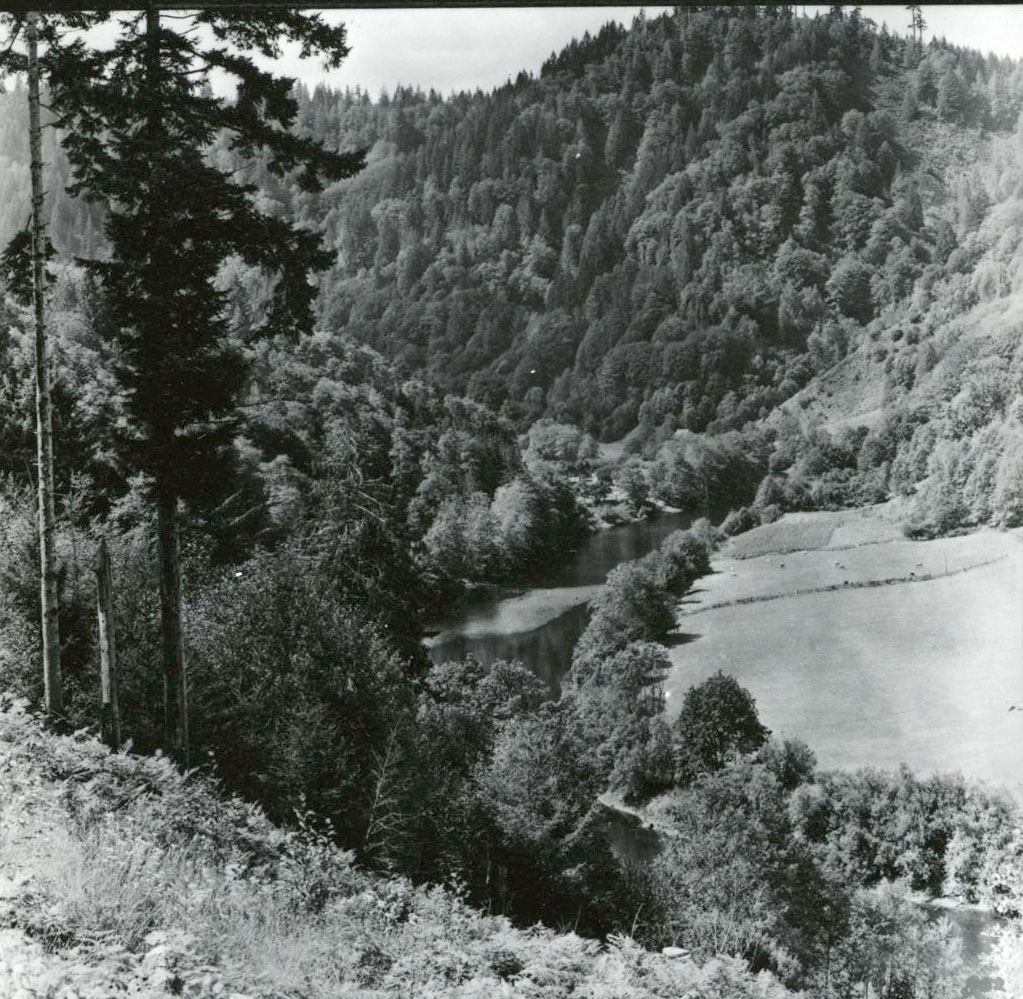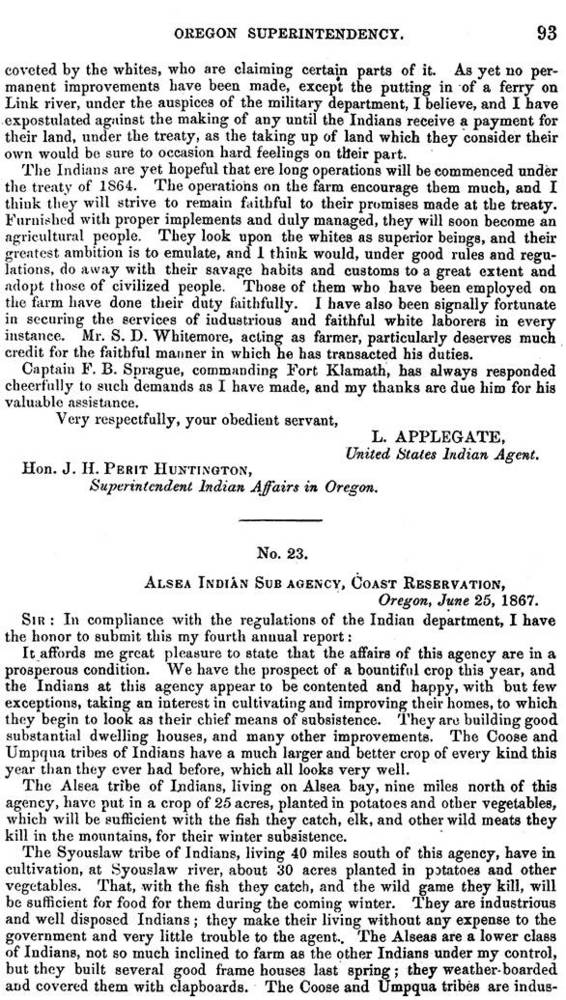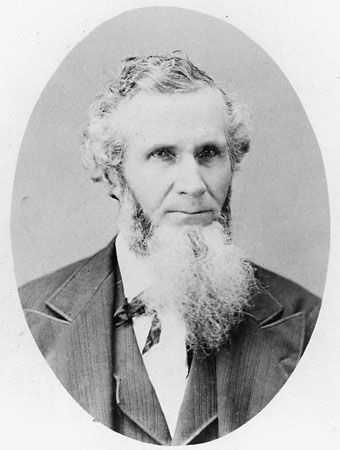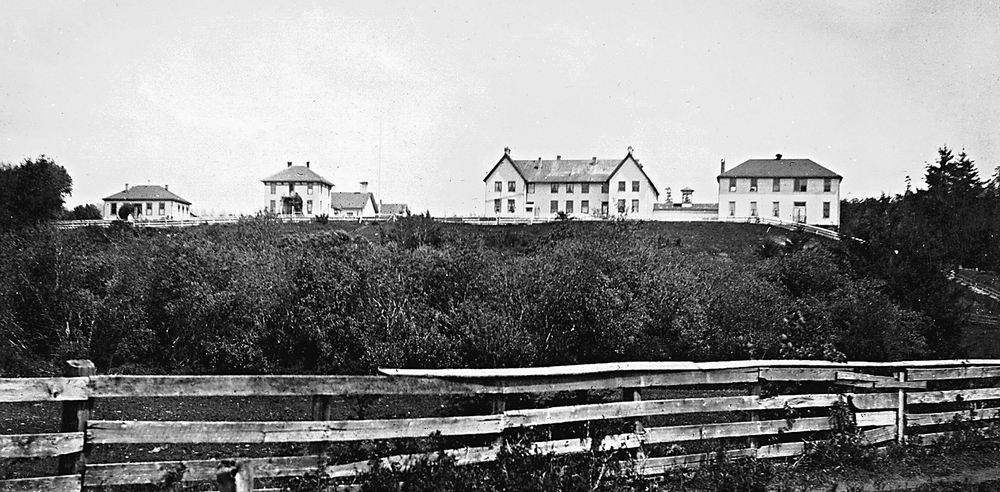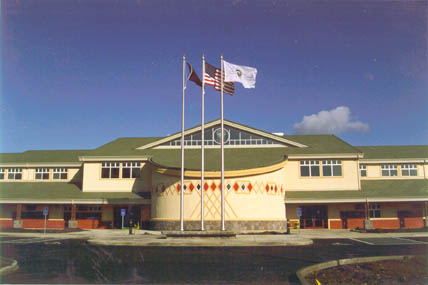In September 1856, Joel Palmer, the Superintendent of Indian Affairs for Oregon, established the Alsea Subagency on the Coast Reservation to manage Indians who lived between Coos Bay and the Alsea River. The federal government managed reservation lands through a series of agencies and subagencies, where federal Indian Agents administered the agency and reported on conditions to the Commissioner of Indian Affairs. The Coast Reservation included the Siletz and Grand Ronde agencies and the Alsea, Yaquina, and Salmon River subagencies. The Alsea Subagency, located on Alsea Bay north of Yachats, was built by Indian laborers and operated until 1875.
President Franklin Pierce established the Coast Reservation by executive order on November 9, 1855. The military then removed the southern Oregon tribes from their homelands and shipped or marched them to the Grand Ronde and Siletz Agencies in different parts of the Coast Reservation.
In 1861, the Army removed the Alseans, Siuslawans, and a small band of Lower Umpquas to the subagency. Through the subagency, Indian Agents administered the Coos, Coquilles, Lower Umpqua, Alsea, and Siuslaw tribes, while they remained on their traditional homelands in Coos Bay and on the Yaquina and Alsea rivers.
Congress reduced the size of the Coast Reservation in 1865, dividing the reservation in roughly thirds with the Grand Ronde Reservation to the north, the Siletz Reservation in the middle, and the Alsea Reservation to the south. Ten years later, Congress reduced the Coast Reservation even further and eliminated the Alsea Reservation. The act directed that "the balance of said Alsea and Siletz reservations is hereby thrown open to settlement under the land laws of the United States." The regional Indian Office moved some of the people on the Alsea Reservation north to the Siletz Reservation, while others stayed in their homelands in off-reservation communities.
Today, descendants of the Alsea Subagency tribes are enrolled at the Confederated Tribes of the Siletz Indians, the Coquille Indian Tribe, and the Confederated Tribes of the Coos, Lower Umpqua, and Siuslaw tribes of Oregon.
-
![]()
Alsea River, c.1937.
Courtesy Oregon Hist. Soc. Research Lib., Oregon Journal Coll.,007463
-
![]()
G. W. Collins' June 1867 report on the Alsea Sub-Agency.
University of Washington Special Collections
-
![Joel Palmer.]()
Palmer, Joel, OrHi27903.
Joel Palmer. Oreg. Hist. Soc. Research Libr., OrHi27903
-
![]()
G. W. Collins' June 1867 report on the Alsea Sub-Agency.
University of Washington Special Collections
Related Entries
-
![Athapaskan Indians]()
Athapaskan Indians
According to Tolowa oral histories, the Athapaskan people of southern O…
-
Coast Indian Reservation
Beginning in 1853, Superintendent of Indian Affairs Joel Palmer negotia…
-
![Confederated Tribes of Grand Ronde]()
Confederated Tribes of Grand Ronde
The Confederated Tribes of Grand Ronde Community of Oregon is a confede…
-
![Hanis Coos (Kowes)]()
Hanis Coos (Kowes)
The Hanis (hanıs) people lived in villages along Coos Bay, Coos River, …
-
![Joel Palmer (1810–1881)]()
Joel Palmer (1810–1881)
Joel Palmer spent just over half of his life in Oregon. He first saw th…
-
![Miluk]()
Miluk
Miluk was one of two related languages spoken by people known collectiv…
-
![Native American Loggers in Oregon]()
Native American Loggers in Oregon
In pre-settlement times, native peoples of the Pacific Northwest Coast …
Related Historical Records
Map This on the Oregon History WayFinder
The Oregon History Wayfinder is an interactive map that identifies significant places, people, and events in Oregon history.
Further Reading
Kappler, Charles J. Indian Affairs: Laws and Treaties. Vol. 1. Washington, D.C.: Government Printing Office, 1913, 1902.
Zenk, Henry B. "Alseans." In Handbook Of North American Indians. Vol. 7. Northwest Coast. Ed. Wayne Suttles. Washington, D.C.: Smithsonian Institution, 1990.
Zenk, Henry B. "Siuslawans and Coosans." In Handbook of North American Indians. Vol. 7. Northwest Coast. Ed. Wayne Suttles. Washington, D.C.: Smithsonian Institution, 1990.

